
Errors on Bank Notes and Currencies
Bank Notes issued by several countries contain many security features, few important amongst them being Security thread and OVD features. In order to enhance the security of the bank notes, these features are added to impede forgery and counterfeiting. It is not possible to eliminate counterfeiting fully whatever be the best feature deployed. Initially it will appear to be difficult to forge with those new features, but the counterfeiters are able to duplicate overt looking similar feature though they may not covertly match them. Since the counterfeiters are able to find some way or the other to forge the notes, the Bank Note issuing authorities try to go in for technology with high cost and intricate technology that makes it highly difficult to counterfeit the notes easily unless the enemy nations and state saboteurs decide to throw their weight to subvert the economy.
Bank Note and Currency production is not as easy as one may imagine. It takes the final shape after undergoing lots of processes both manual and mechanical. Even though at each stage the production process undergoes very strict quality control that look for any mistakes, at times normal human error lead to error on the notes produced. Errors normally occur during the printing process. Banknotes are printed in various stages and ways, and some of those methods can throw up different types of errors. Sometimes the error is detected only at the end of production leading to not only loss of production, but also the cost. If by mistake the notes with error goes into circulation, then it becomes a prized collector item and those responsible for releasing them with error face the music from the authorities. Therefore even in the most modernized units random sample checking is resorted to manually to ensure that every process goes in order.
Some of the print errors occur during printing. The error need not occur only during processing or printing, but it can also occur even from the stage of designing which will remain unnoticed as the intricate design elements are complicated and cannot be easily noticed. The errors can also occur due to mismanagement which includes procurement of material like that of Paper and ink. There were instances in many units that the defects in the paper or ink lead to print errors which were noticed at the end of production leading to destruction of the entire printed lots of the particular series in bank notes and currencies. Some of the errors remain unnoticed till someone from the public reported them or someone in the press itself accidentally noticed it. What type of errors normally occur in the presses and during processing ? Errors in the text printed on banknotes are the most common design error on banknotes, and this type of error has occurred on many notes over the years.
- Design errors
- Missing security features
- Wrongly printed texts
- Wrong numbering
- Fine crease in the finished notes which remain invisible.
- Trimmed note size not proper
- Missing colors in designs
- Improper color
- Wrong prints which includes ghost images, improper prints etc.
- Watermark defects
Acknowledgement: This article contains valuable and interesting info from the article ‘Bank Note Oddities’ written by Mr. Peter Symes (p j symes) in the year 2001. Mr. Peter Symes is an expert author on world paper money and has published many articles and books.I sincerely thank Mr. Peter Symes who has given me special permission to use the inputs from his articles and to reproduce them in this blogger for the benefit of the Security printers and Students – N.R. Jayaraman
Mr. Peter Symes article detail some of the major errors that have crept in the bank notes printed by some of the countries. Read the following which display the error list as reproduced by Mr. Peter Symes . However some have also been added by me to update the knowledge:
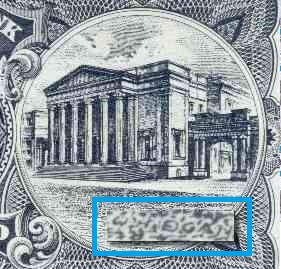
3) In 1954 Canada issued a series of notes that contained a portrait of Queen Elizabeth II on the front of each denomination. It was not long before it was observed that the Queen’s hair, to the right of her left ear, contained an image that could be interpreted as the face of a ‘devil’. Appearing to have a large nose, the shadow of a thick lip, and two bulging eyebrows, the detection of the image brought some concern to the authorities responsible for issuing the notes. Consequently, in 1955, the banknotes were re-issued with the Queen’s hair redrawn.
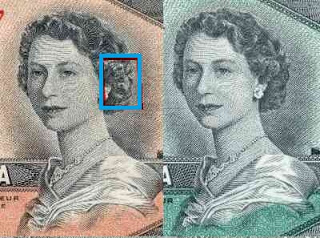
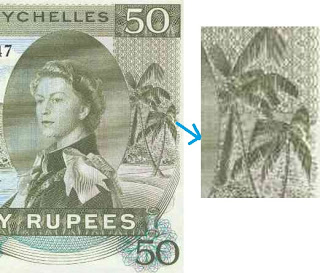
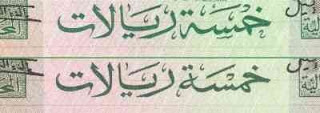
The front of the 5-rial note has an illustration of dwellings built against a steep hill and the Annual Report of the Central Bank of Yemen for 1973 stated that the buildings depicted were in the town of Zabeid. However, the illustration was of houses in the Wadi Du’an, which is in South Yemen. The illustration was adapted from a photograph taken by a German adventurer named Hans Helfritz. It was strange that an illustration of buildings in South Yemen appeared on a banknote issued in North Yemen, seventeen years before the unification of the two countries was however an unintentional mistake.
It is probable that the banknote designers know very little about the geography of Yemen and probably didn’t realize that the photograph was of a village in the wrong country. It is also unlikely that many Yemeni people realized that the illustration was of dwellings in a neighboring country.
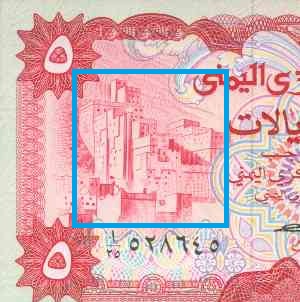
7) In the year 1980 Kuwait introduced their third series of banknotes. At sometime after 1986 slight modifications were made to the notes, one of which was the addition of lines of micro-printed text. On the front of the notes ‘Central Bank of Kuwait’ was repeated in micro-printed English text. On the back of the notes the same phrase was written in micro-printed Arabic text.
Despite the quality control mechanisms of Thomas De La Rue and Company, the micro-printing was not correctly applied to the 5-dinar note. On this particular denomination, the correct micro-printed text appeared on the front of the note, but the micro-printed Arabic text on the back of this denomination reads ‘Central Bank of Yemen’.
Thomas De La Rue which later prepared a new 20-rial note for the Central Bank of Yemen, which included a line of micro-printing. It would appear that the machinery, which applied the micro-printing to the printing plates, was prepared with the wrong string of text and the text prepared for the Central Bank of Yemen was executed on the 5-dinar note issued by the Central Bank of Kuwait. The error was apparently never picked up, either by the Central Bank of Kuwait or Thomas De La Rue, as all notes of this type had the error on it.
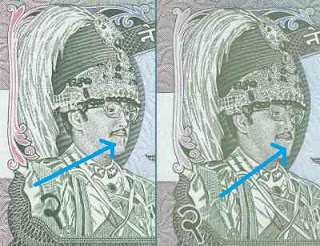
10) A third incident of a fault in depicting a monarch occurred on the 50-baht note issued by Thailand in 1985. On this particular note King Rama IX is depicted with pointed ears, which give him a slightly pixie-like appearance. The embarrassing mistake was soon noticed and the notes were subsequently modified to obscure the pointed tips of the ears.
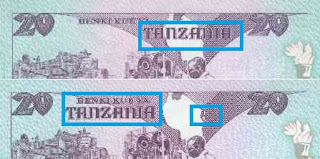
12) In the year 1991, Peru issued 100-nuevos-soles note and wrongly mentioned the name of the person on the note as ‘Jorge Basadre’ instead of ‘Jorge Basadre Grohman’. The said mistake was corrected in the next batch of notes issued.
However, the change in order almost brought the country to its knees. Within days of the banknotes being issued, Tamils were protesting and burning effigies of the Governor of the Bank of Mauritius, Tamil members of Parliament threatened to resign, and representations were made to the President of Mauritius. Ultimately, the notes were re-issued with the text in the correct order and peace was restored to Mauritius. However, both the Governor and the Managing Director of the Bank of Mauritius lost their jobs over the incident.
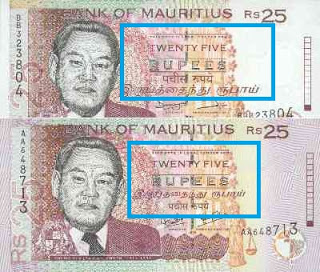
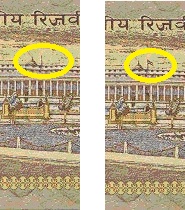
17) News 24, on its online news edition (http://www.news24.com/SouthAfrica/News/Costly-mistake-with-defective-R100-20120520) and Novalis Ubundu in their online news letter (http://www.novalis.org.za/costly-mistake-with-defective-outsourced-r100-notes-by-swedish-company/) carried an news item stating that the The Reserve Bank of South Africa has to shred more than 3.6 million of R100 notes as the bank notes printed in Sweden, had the same serial numbers as a batch printed locally besides variation in color and cut note size which caused problems on automated machines.
18) Errors occur for various reasons during the manufacturing stages of bank notes. Such reasons include ink starvation, spilled ink, incorrectly positioned sheet, folded sheet, joined sheets, alien material, machinery failure, and others. These and other reasons can appear simultaneously on the same bank note. Error bank notes descriptions and images of error bank notes as compiled by Mr. Stane Štraus has been shown in the site –http://www.polymernotes.org/resources/errornotes.htm– of http://www.polymernotes.org/resources.htm grouped into several categories. Please go to the said site and see the details.













Recent Comments